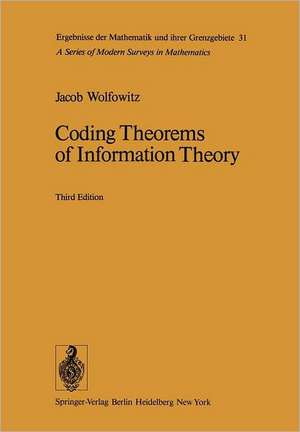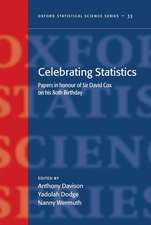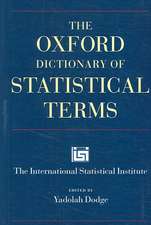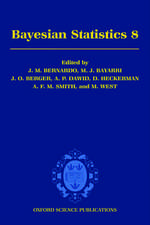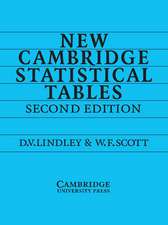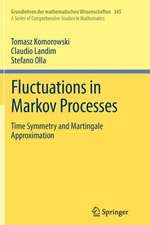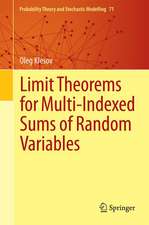Coding Theorems of Information Theory: ERGEBNISSE DER MATHEMATIK UND IHRER GRENZGEBIETE 2 FOLGE, cartea 31
Autor J. Wolfowitzen Limba Engleză Paperback – 15 noi 2011
Din seria ERGEBNISSE DER MATHEMATIK UND IHRER GRENZGEBIETE 2 FOLGE
-
 Preț: 442.02 lei
Preț: 442.02 lei -
 Preț: 409.43 lei
Preț: 409.43 lei -
 Preț: 484.47 lei
Preț: 484.47 lei -
 Preț: 376.96 lei
Preț: 376.96 lei -
 Preț: 491.72 lei
Preț: 491.72 lei - 15%
 Preț: 704.04 lei
Preț: 704.04 lei -
 Preț: 345.71 lei
Preț: 345.71 lei -
 Preț: 383.12 lei
Preț: 383.12 lei -
 Preț: 382.95 lei
Preț: 382.95 lei - 15%
 Preț: 636.45 lei
Preț: 636.45 lei -
 Preț: 489.87 lei
Preț: 489.87 lei -
 Preț: 387.75 lei
Preț: 387.75 lei - 15%
 Preț: 493.56 lei
Preț: 493.56 lei -
 Preț: 393.35 lei
Preț: 393.35 lei -
 Preț: 377.95 lei
Preț: 377.95 lei -
 Preț: 384.31 lei
Preț: 384.31 lei -
 Preț: 413.07 lei
Preț: 413.07 lei -
 Preț: 380.25 lei
Preț: 380.25 lei -
 Preț: 412.68 lei
Preț: 412.68 lei -
 Preț: 385.62 lei
Preț: 385.62 lei -
 Preț: 415.39 lei
Preț: 415.39 lei -
 Preț: 376.59 lei
Preț: 376.59 lei -
 Preț: 379.48 lei
Preț: 379.48 lei -
 Preț: 483.27 lei
Preț: 483.27 lei -
 Preț: 414.42 lei
Preț: 414.42 lei - 15%
 Preț: 579.67 lei
Preț: 579.67 lei -
 Preț: 419.06 lei
Preț: 419.06 lei - 18%
 Preț: 1108.67 lei
Preț: 1108.67 lei - 15%
 Preț: 578.37 lei
Preț: 578.37 lei -
 Preț: 381.43 lei
Preț: 381.43 lei -
 Preț: 383.12 lei
Preț: 383.12 lei -
 Preț: 375.45 lei
Preț: 375.45 lei -
 Preț: 171.74 lei
Preț: 171.74 lei -
 Preț: 150.03 lei
Preț: 150.03 lei -
 Preț: 381.00 lei
Preț: 381.00 lei -
 Preț: 413.27 lei
Preț: 413.27 lei -
 Preț: 410.17 lei
Preț: 410.17 lei -
 Preț: 381.21 lei
Preț: 381.21 lei -
 Preț: 383.12 lei
Preț: 383.12 lei -
 Preț: 480.83 lei
Preț: 480.83 lei -
 Preț: 375.62 lei
Preț: 375.62 lei -
 Preț: 382.36 lei
Preț: 382.36 lei -
 Preț: 383.50 lei
Preț: 383.50 lei -
 Preț: 181.74 lei
Preț: 181.74 lei -
 Preț: 408.77 lei
Preț: 408.77 lei -
 Preț: 359.54 lei
Preț: 359.54 lei -
 Preț: 376.43 lei
Preț: 376.43 lei
Preț: 636.63 lei
Preț vechi: 748.97 lei
-15% Nou
Puncte Express: 955
Preț estimativ în valută:
121.84€ • 126.73$ • 100.58£
121.84€ • 126.73$ • 100.58£
Carte tipărită la comandă
Livrare economică 14-28 aprilie
Preluare comenzi: 021 569.72.76
Specificații
ISBN-13: 9783642668241
ISBN-10: 3642668240
Pagini: 192
Ilustrații: XII, 176 p.
Dimensiuni: 170 x 244 x 10 mm
Greutate: 0.31 kg
Ediția:3rd ed. 1978. Softcover reprint of the original 3rd ed. 1978
Editura: Springer Berlin, Heidelberg
Colecția Springer
Seria ERGEBNISSE DER MATHEMATIK UND IHRER GRENZGEBIETE 2 FOLGE
Locul publicării:Berlin, Heidelberg, Germany
ISBN-10: 3642668240
Pagini: 192
Ilustrații: XII, 176 p.
Dimensiuni: 170 x 244 x 10 mm
Greutate: 0.31 kg
Ediția:3rd ed. 1978. Softcover reprint of the original 3rd ed. 1978
Editura: Springer Berlin, Heidelberg
Colecția Springer
Seria ERGEBNISSE DER MATHEMATIK UND IHRER GRENZGEBIETE 2 FOLGE
Locul publicării:Berlin, Heidelberg, Germany
Public țintă
ResearchCuprins
1. Heuristic Introduction to the Discrete Memoryless Channel.- 2. Combinatorial Preliminaries.- 2.1. Generated sequences.- 2.2. Properties of the entropy function.- Remarks.- 3. The Discrete Memoryless Channel.- 3.1. Description of the channel.- 3.2. A coding theorem.- 3.3. The strong converse.- 3.4. Strong converse for the binary symmetric channel.- 3.5. The finite-state channel with state calculable by both sender and receiver.- 3.6. The finite-state channel with state calculable only by the sender.- Remarks.- 4. Compound Channels.- 4.1. Introduction.- 4.2. The canonical channel.- 4.3. A coding theorem.- 4.4. Strong converse.- 4.5. Compound d.m.c. with c.p.f. known only to the receiver or only to the sender.- 4.6. Channels where the c.p.f. for each letter is stochastically determined.- 4.7. Proof of Theorem 4.6.4.- 4.8. The d.m.c. with feedback.- Remarks.- 5. The Discrete Finite-Memory Channel.- 5.1. The discrete channel.- 5.2. The discrete finite-memory channel.- 5.3. The coding theorem for the d.f.m.c..- 5.4. Strong converse of the coding theorem for the d.f.m.c.- 5.5. Rapidity of approach to C in the d.f.m.c.- 5.6. Discussion of the d.f.m.c.- Remarks.- 6. Channels with Arbitrarily Varying Channel Probability Functions.- 6.1. Introduction.- 6.2. Necessary and sufficient conditions for a positive rate of transmission.- 6.3. Remarks on the capacity of an arbitrarily varying channel.- 6.4. The capacity C of an arbitrarily varying channel when b = 2.- 6.5. Certain results for the general arbitrarily varying channel.- Remarks.- 7. General Discrete Channels.- 7.1. Alternative description of the general discrete channel.- 7.2. The method of maximal codes.- 7.3. The method of random codes.- 7.4. Weak converses.- 7.5. Digression on the d.m.c.- 7.6. Discussion of the foregoing.- 7.7. Channels without a capacity.- 7.8. Strong converses.- 7.9. The strong converse for the d.m.c. revisited.- Remarks.- 8. The Semi-Continuous Memoryless Channel.- 8.1. Introduction.- 8.2. A coding theorem and its strong converse.- 9. Continuous Channels with Additive Gaussian Noise.- 9.1. A continuous memoryless channel with additive Gaussian noise.- 9.2. Message sequences within a suitable sphere.- 9.3. Message sequences on the periphery of the sphere or within a shell adjacent to the boundary.- 9.4. Another proof of Theorems 9.2.1 and 9.2.2.- Remarks.- 10. Mathematical Miscellanea.- 10.1. Introduction.- 10.2. The asymptotic equipartition property.- 10.3. Admissibility of an ergodic input for a discrete finite-memory channel.- 11. Fundamentals of Rate Distortion Theory.- 11.1. Introduction.- 11.2. The approximation theorem.- 11.3. Converse of the approximation theorem.- 11.4. Summary of the previous results.- 11.5. The rate distortion function when side information is available.- Remarks.- 12. Source Coding.- 12.1. Separate coding to span the product of two spaces.- 12.2. Source coding with side information at the decoder.- 12.3. Encoding assisted by a common channel.- Remarks.- 13. Source Coding and Rate Distortion.- 13.1. The problem of Section 12.3 for rate distortion.- 13.2. The rate distortion function for source coding with side information at the decoder.- 14. Multiple Access Channels.- 14.1. Description of the problem.- 14.2. A coding theorem.- 14.3. Converse of the coding theorem.- 14.4. Miscellaneous remarks.- 15. Degraded Broadcast Channels.- 15.1. Formulation of the problem.- 15.2. A coding theorem.- 15.3. Beginning of the proof of the strong converse.- 15.4. Proof of the weak converse.- 15.5. Miscellaneous remarks.- References.
